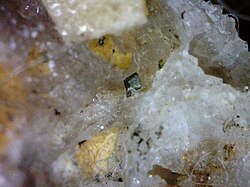| Vaesite | |
|---|---|
 Vaesite on a matrix | |
| General | |
| Category | Sulfide minerals |
| Formula | Ni S 2 |
| IMA symbol | Va [1] |
| Crystal system | Isometric |
| Identification | |
| Color | Black, silver-gray |
| Cleavage | Distinct/good {001} |
| Mohs scale hardness | 4.5–5.5 |
| Luster | Metallic |
| Streak | Black |
| Diaphaneity | Opaque |
| Specific gravity | 4.45 |
| References | [2] |
Vaesite (Ni S 2) is a mineral found together with cattierite in the Democratic Republic of Congo. It is named after Johannes F. Vaes, a Belgian mineralogist. [3] It is part of the pyrite group. [2]